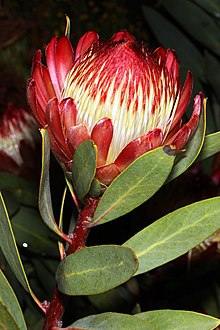bio.wikisort.org - Plant
Protea glabra, also called the Clanwilliam sugarbush,[3][4][5] is a flowering shrub belonging to the genus Protea.[5]
| Protea glabra | |
|---|---|
 | |
Conservation status | |
| Scientific classification | |
| Kingdom: | Plantae |
| Clade: | Tracheophytes |
| Clade: | Angiosperms |
| Clade: | Eudicots |
| Order: | Proteales |
| Family: | Proteaceae |
| Genus: | Protea |
| Species: | P. glabra |
| Binomial name | |
| Protea glabra | |
| Synonyms[3] | |
| |
Other vernacular names for this plant are chestnut sugarbush, Clanwilliam protea or kayang bush. In Afrikaans it is known as the kaiingbos, kaiing-suikerbos, kaiinghout, kayangbos, kreupelwaboom or tolletjiewaboom.[3]
The tree's national number is 89.1.[6]
Description
The bush grows up to 5m high and has a conical shape. It blooms from July to November. The plant is monoecious with both sexes in each flower.[5]

Ecology
Pollination occurs through the action of birds[3][5] and beetles.[5] The seed is not stored in the woody fruit and is spread by the wind as soon as it is ripe.[3][5] The plant grows in shallow sandstone soils or cracks in rock at altitudes of 500 - 1,500m.[5] It is long-lived and can re-sprout after burning from a bole-shaped rootstock, although it normally grows in areas where there is low risk of wildfires.[3][5]
Distribution
This species is endemic to South Africa.[3] The plant is found in the Western Cape, on the Bokkeveld escarpment up to the Olifants River and the Koue Bokkeveld Mountains.[5] Here, it is a widespread and common species with no severe threats.[3]
References
- Rebelo, A.G.; Mtshali, H.; von Staden, L. (2020). "Protea glabra". IUCN Red List of Threatened Species. 2020: e.T113209916A185566623. doi:10.2305/IUCN.UK.2020-3.RLTS.T113209916A185566623.en. Retrieved 19 November 2021.
- Kuntze, Otto (1891). Revisio Generum Plantarum: vascularium omnium atque cellularium multarum secundum leges nomeclaturae internationales cum enumeratione plantarum exoticarum in itinere mundi collectarum (in German). Vol. 2. Leipzig: A. Felix. p. 590. doi:10.5962/bhl.title.327.
- Rebelo, A.G.; Mtshali, H.; von Staden, L. (15 April 2019). "Clanwilliam Sugarbush". Red List of South African Plants. version 2020.1. South African National Biodiversity Institute. Retrieved 11 July 2020.
- "Protea glabra (Clanwilliam sugarbush)". Biodiversity Explorer. Iziko - Museums of South Africa. Retrieved 7 July 2020.
- "Shaving-bush Sugarbushes - Proteas". Protea Atlas Project Website. 11 March 1998. Retrieved 7 July 2020.
- "National List of Indigenous Trees in South Africa".
На других языках
- [en] Protea glabra
[ru] Protea glabra
Protea glabra (лат.) — кустарник, вид рода Протея (Protea) семейства Протейные (Proteaceae)[3][4][5], эндемик Южной Африки[3].Другой контент может иметь иную лицензию. Перед использованием материалов сайта WikiSort.org внимательно изучите правила лицензирования конкретных элементов наполнения сайта.
WikiSort.org - проект по пересортировке и дополнению контента Википедии
